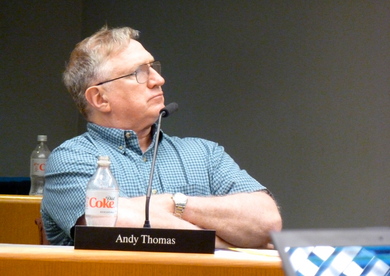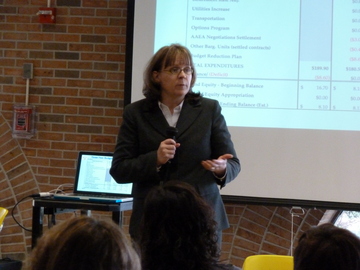After years of budget cuts and drawing down its fund balance, the Ann Arbor Public Schools has been forced to borrow money for the first time in its history.
The Board of Education passed a resolution Wednesday night authorizing district officials to obtain a line of credit in the amount of $10 million to fund school operations.
Clik here to view.

Ann Arbor board Secretary Andy Thomas looks at a powerpoint presentation as Finance Director Nancy Hoover discusses the district's third-quarter financial report, which shows the AAPS needs to add another $1.3 million to its current-year budget deficit.
Danielle Arndt | AnnArbor.com
The majority of a district's revenue is from the per-pupil foundation allowance it receives from the state. The Michigan Department of Education disburses this money throughout the fiscal year, which for the state runs from Oct. 1 through Sept. 30, as opposed to July 1 through June 30 for most school districts.
Districts with a healthy fund balance, or primary savings account, do not need to borrow money from the state or other entity to make payments. They can front the money necessary for payroll and operations from their fund balances and replace the transfer with the money from the state aid payment when it comes.
Director of Finance and Chief Executive Officer for the AAPS, Nancy Hoover, said Wednesday the amount the district would need in its fund equity in order to make payroll is between $14 and $16 million.
"We were able to make our payrolls last year when we had $16 million (in fund equity), but it was tight," she said.
AAPS has been one of only a few remaining districts in the county that did not borrow money from the state of Michigan. Borrowing is not that uncommon due to the state government and school districts being on two different calendars/fiscal years. The Michigan Department of Treasury offers a loan program to traditional public schools to finance short-term operational cash flow needs.
However, Hoover said AAPS will not be borrowing from the state, but instead will seek a line of credit through a bank. She said it's the less expensive route, as the interest rates should be lower.
AAPS began the 2012-13 academic year with $16.63 million in fund equity. However, according to the district's third quarter financial report, which also was presented to the board Wednesday, the district will finish this school year with just $6.8 million. This in part is due to a current-year budget shortfall of $3.8 million.
It was announced that the district had a deficit of $2.5 million in February. But from February to May, the shortfall has grown by another $1.3 million.
According to the third-quarter financial report presented Wednesday, the district's substitute teacher budget was increased by $300,000; and an extra $300,000 was budgeted for health care to cover anticipated usage through the remainder of the year; and an additional $700,000 for transportation was needed, due to increased fuel costs, and increased costs for maintenance and substitute drivers, as well as costs associated with transporting homeless students.
Clik here to view.

Nancy Hoover addresses a group of parents, students, staff and community members at a budget forum at Huron High School on May 2.
Danielle Arndt | AnnArbor.com
"I continue to be frustrated that these things keep popping up and biting us on the keister," said board Secretary Andy Thomas. "... We are talking about the price of gasoline costing us $700,000 more than we anticipated. ... And we are just now finding out about this in May.
"I would think that much of this would have become evident by October or certainly sometime in November. I am increasingly frustrated by having these budget adjustments come along six months after the fact."
Wednesday was the first reading of the third-quarter financial report and budget adjustment resolution. The board will vote on the resolution at its next regular meeting on May 22.
Hoover explained many of these issues are coming to light as the finance department continues to move from bottom-line accountability budgeting to line-by-line accountability, the first step of implementing zero-based budgeting. That method of budgeting puts every item at zero at the beginning of the budgeting process and then allows the district to allocate money for each according to its priorities.
But in addition to gas costs, Hoover said, there also were increased maintenance costs and costs incurred because the Washtenaw Intermediate School District, with which AAPS contracts for transportation services through a consortium with Ypsilanti and Willow Run, is having a difficult time finding substitute drivers. Because of this, the WISD is having to pay substitute drivers a higher rate, she said.
Trustee Susan Baskett asked: If it's the WISD's responsibility to find the drivers, then why is it Ann Arbor's books on the line? Hoover said this is because of the district's contract with the WISD.
"It's different than if we had privatized bus service," Hoover said, explaining if the district had privatized, a company then would have provided the set service for a fee. "But this is a pass-though. Whenever additional costs then incur beyond that, (they)are passed on to the districts in the consortium."
Trustee Simone Lightfoot said she was concerned about how much money the district actually saved by contracting with the WISD. But Hoover said the district previously spent about $7 million on transportation. Even with the increased expense, the district still is spending about $2.5 million less through the WISD.
Superintendent Patricia Green said the Washtenaw Intermediate School District just called a meeting about three weeks ago with the consortium districts to inform them of the increased costs of transportation.
"We were shocked at the meeting when we got the information," she said.
Hoover added that student homelessness is on the rise and is still a "new phenomenon" school districts are dealing with: "It's not really something we can project very easily. And it's not something we really have incurred in the past."
The district enacted a spending freeze around February to deal with the current-year deficit. Hoover said she is hopeful school officials will not end up spending all that they budgeted for and the district will be able to close the budget gap and not have to transfer it over into next year.
Green emphasized the importance of continuing to move toward zero-based budgeting.
"Unless that takes root, this popping up (of expenses) will happen over and over again," she said. "In the old days when there was excess, you could transfer from one part of the budget to another to fill the gap, but there is no excess there anymore."
Green said the biggest thing about line-by-line accountability is "you are seeing the shortfalls. Before, you didn't know what you weren't budgeting appropriately.
"Budgets were built on projections from previous years that were not accurate. ... I won't be here in the future, but the blueprint will be here and Nancy (Hoover) is the architect going forward." Green announced her resignation earlier this year.
She told the board it would have to be patient because it takes time to recreate this process that, historically, has been done from the bottom up for years and years.
"It's building the bridge as you're crossing it."
Danielle Arndt covers K-12 education for AnnArbor.com. Follow her on Twitter @DanielleArndt or email her at daniellearndt@annarbor.com.